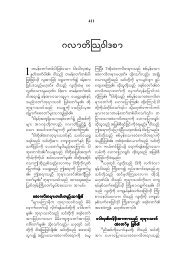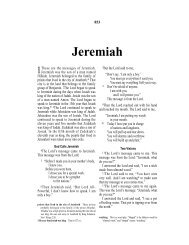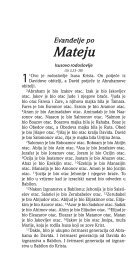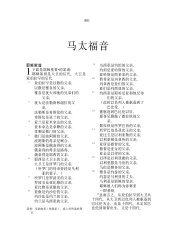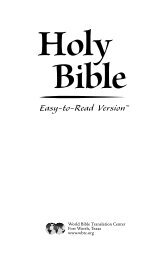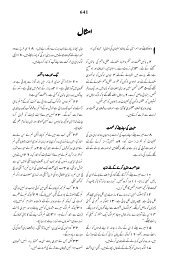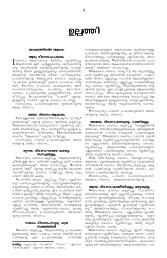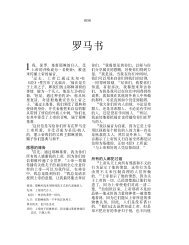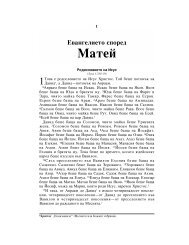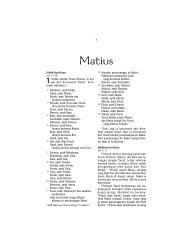English Version for the Deaf
English Version for the Deaf
English Version for the Deaf
You also want an ePaper? Increase the reach of your titles
YUMPU automatically turns print PDFs into web optimized ePapers that Google loves.
PREFACE vi<br />
is much more than that. It is a carefully constructed translation, designed to<br />
communicate to those who are deaf. Although <strong>the</strong> language used will not be<br />
familiar to those accustomed to standard <strong>English</strong> versions, it does convey to<br />
<strong>the</strong> deaf <strong>the</strong> meaning that was originally intended.<br />
It is <strong>the</strong> purpose of this translation to provide <strong>the</strong> deaf with <strong>the</strong>ir own Bible<br />
<strong>for</strong> personal reading and study and to aid <strong>the</strong> vital ministry of those who<br />
teach <strong>the</strong> deaf, giving <strong>the</strong>m relief from <strong>the</strong> need to "translate" existing<br />
<strong>English</strong> versions as <strong>the</strong>y teach.<br />
The translation is based directly on <strong>the</strong> original languages of Scripture. In<br />
<strong>the</strong> case of <strong>the</strong> Old Testament, <strong>the</strong> translators followed <strong>the</strong> Hebrew<br />
Masoretic Text as it is found in <strong>the</strong> latest printed edition of Biblia Hebraica<br />
Stuttgartensia (1984), while referring occasionally to some earlier readings<br />
in <strong>the</strong> Dead Sea Scrolls. In some cases, <strong>the</strong>y also followed <strong>the</strong> Septuagint<br />
(LXX), <strong>the</strong> Greek translation of <strong>the</strong> Old Testament, where it has readings<br />
that are actually earlier than any known Hebrew manuscript. For <strong>the</strong> New<br />
Testament, <strong>the</strong> source text was that which is found in both <strong>the</strong> United Bible<br />
Societies' Greek New Testament (third edition, 1975 and fourth revised edition,<br />
1993) and <strong>the</strong> Nestle-Aland Novum Testamentum Graece (twenty-seventh<br />
edition, 1993). The occasional variation from <strong>the</strong>se printed editions<br />
was guided by reference to <strong>the</strong> findings of more recent scholarship.<br />
Several special features are used to aid understanding. Brief explanations or<br />
synonyms (italicized within paren<strong>the</strong>ses) sometimes follow difficult or<br />
ambiguous words in <strong>the</strong> text. Words or phrases that need fuller explanation<br />
are followed by an asterisk (*) and explained in footnotes at <strong>the</strong> bottom of<br />
<strong>the</strong> page. In addition, footnotes often identify Scripture quotations or give<br />
alternate readings when significant differences occur in <strong>the</strong> ancient<br />
manuscripts.<br />
As in all translations, words that are implied by <strong>the</strong> context are often supplied<br />
in <strong>the</strong> text to make <strong>the</strong> meaning clear. For example, <strong>the</strong> phrase that in<br />
Greek is simply "David of Jesse" is always translated into <strong>English</strong> as<br />
"David <strong>the</strong> son of Jesse." If such explanatory words or phrases are extensive<br />
or unusual, <strong>the</strong>y may be marked by half brackets. For example, in <strong>the</strong> translation,<br />
"The Lord gave this command to Moses {<strong>for</strong> <strong>the</strong> people}," <strong>the</strong> phrase<br />
in half brackets is added to avoid any misunderstanding that <strong>the</strong> Lord's command<br />
was intended only <strong>for</strong> Moses and not <strong>for</strong> all <strong>the</strong> people.<br />
Finally, in <strong>the</strong> Gospels, <strong>the</strong> first four books of <strong>the</strong> New Testament, <strong>the</strong> section<br />
headings are often followed by cross references. These identify where<br />
<strong>the</strong> same or similar material is found in one or more of <strong>the</strong> o<strong>the</strong>r Gospels.



